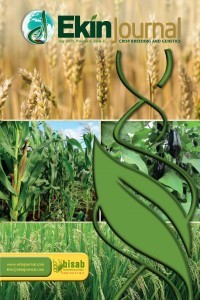Heterotic Effects for Lint Yield in Double Cross Hybrids on Cotton
Heterotic Effects for Lint Yield in Double Cross Hybrids on Cotton
cotton, double cross lint yield, heterosis, heterobeltiosis,
___
- Chaing MS and Smith JD (1967). Diallel analysis of inheritance of quantitative characters in grain sorghum. I.Heterosis and inbreeding depression. Canadian Journal Genet. Cyto. 9:44-51.
- Fehr WR (1987). Principles of cultivar development. Theory and techniques. Vol.1. McGrawhill, New York, USA.
- Fonseca SM and Patterson FL (1968). Hybrid Vigour in a Seven Parent Diallel Cross in Common Winter Wheat (T. avestivium L.) Crop Sci. 8 (1): 85-88.
- Griffing LB (1956). Generalized Treatment of the Use of Diallel Crosses in Quantitative Inheritance. Heredity 10: 31-50.
- Hallauer AR and Miranda JB (1982). Quantitative Genetics in Maize Breeding. Iowa State Univ. Pres. Ames. USA.
- Khan IA, IF A Khan and M Ahmad (1981). Study of Gene Action and Combining Ability In Various Characters of Cotton (Gossypium hirsutum L.). Cotton and Trop. Fib. Abst.6-9: 1117.
- Kumar KJY (2008). Combining ability and heterosis studies in experimental hybrids of cotton (Gossypium hirsutum L.). MSc. Thesis, Dept. of Genetics and Plant Breed. College of Agric. Dharwad Univ. of Agr. Sci.,
- Marani A (1968) Heterosis and Inheritance of Quantitative Characters in Interspesific Crosses of Cotton. Crop Science: 8: 299-303.
- Poehlman MJ (1959). Breeding Field Crops. Holt Rine Hart and Winston, ınc., New York. Singh RK and Chaudhary BD (1985). Biometrical Methods in Quantitative Genetic Analysis. Published by Mrs. Usha Raj Kumar for Kalyani Publishers, New Delhi. Revised Edition 1985. Page: 140-146.
- Snedecor GW and Cochran WG (1967). Statistical Methods. The Iowa State College Press, Ames, IOWA, USA. 161-413.
- Stoskopf NS, Tomes DT and Christie BR (1993). Plant Breeding. Theory and Practice. San Francisco: Westview Press Inc.
- Turner JM, (1953). A study of heterosis in upland cotton II Combining ability and inbreeding effects. Agron. J. 43: 487-490.
- ISSN: 2149-1275
- Yayın Aralığı: Yılda 2 Sayı
- Başlangıç: 2015
- Yayıncı: Bitki Islahçıları Alt Birliği
Goksel Evci, Veli PEKCAN, İbrahim M. YİLMAZ, Nesrin CITAK, Nilüfer TUNA, Onur AY, Altug Pilaslı, Yalcin Kaya
Heterotic Effects for Lint Yield in Double Cross Hybrids on Cotton
Remzi Ekinci, Sema Basbag, Oktay Gencer
GGE Biplot Analysis of Multi-Environment Yield Trials in Barley (Hordeum vulgare L.) Cultivars
Syarifah Iis Aisya, Sri Wahyuni, Muhammad Syukur, Joko Ridho Witono
Interrelationship Between 1000 Seed Weight with Other Quantitative Traits in Confectionary Sun ower
Nada Hladni, Siniša Jocić, Vladimir Miklič, Dragana MİLADİNOVİĆ, Miroslav ZORİĆ
Assessment of Drought Resistance in Indian Wheat Cultivars for Morpho-Physiological Traits
Renu Munjal, Satyavir Singh Dhanda
Vikender KAUR, Sunder SİNGH, Rishi Kumar BEHL
Creating Varieties of The Perennial Cereal Grasses by The Polycross Method in Northern Kazakhstan
Nikolay Tsenov, Dobrinka Atanasova, Todor Gubatov
Tomato Varieties with High Indices of Productivity and Resistance to Environmental Factors
